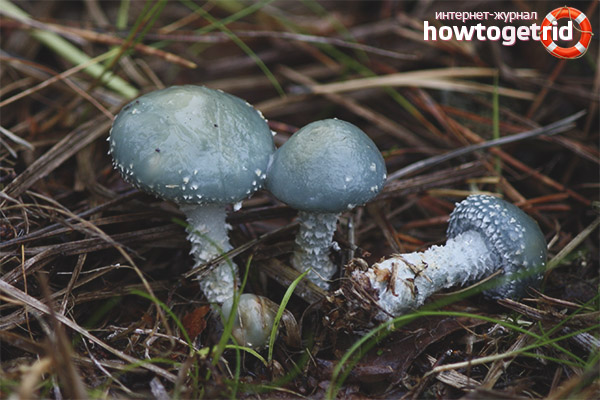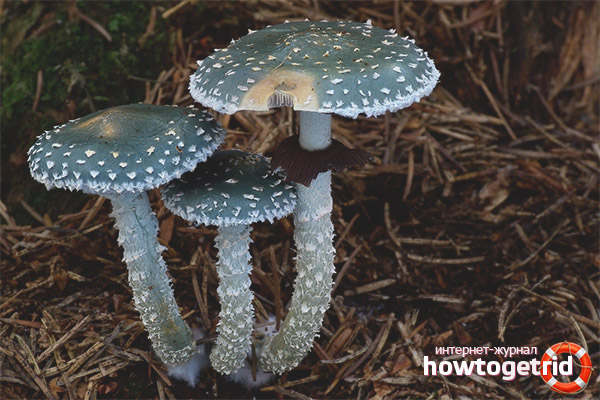The content of the article
Blue-green stropharia belongs to the Strofariyev family and is considered one of the most unusual representatives of this family. Often they are called “birds,” “angels,” and “little folk.” Despite such funny names, the mushroom can be hazardous to health. The season of its growth occurs in late summer and throughout autumn, when the temperature varies from 10 to 20 degrees. Mushrooms are saprotrophs, that is, their nutrition consists of the organic remains of dead plants, trees and animals.
Appearance and morphological signs of the fungus
The appearance of the mushroom is unusual, since the color of the hat is bluish or turquoise. Its diameter is from 2 to 8 centimeters, during high humidity, it is covered with a sticky, slimy mass, which is also a greenish tint. When the mucus dries, it becomes a light green color, and the hat is covered with small dots, like a fly agaric. Its shape depends on the age of the fungus: in young individuals it is in the shape of a dome, and in adults - in the form of a plate, sometimes with fibrous edges. Also in it are the spores by which the fungus multiplies. They are oval in shape, with a smooth shell and brown color. Over time, the color of the hat is lost, and it becomes white-yellow.
The structure of stropharia is pleasant to the touch, not too crumbly, but soft and elastic. When interacting with the environment, the white flesh may turn yellow. It smells like radish in smell. With all the rules of cooking, the output is a pleasant island mushroom taste.
There are many plates, and they are tightly connected to the leg at the base, first they are khaki or blue, and then they change and become gray or dirty purple. The leg is not the same as most representatives of grebes. It is dense in structure, wide enough, and its diameter is from half a centimeter to two. The maximum height of the legs can reach ten centimeters. Despite the apparent massiveness, inside the leg has nothing. It also has a ring, characteristic of even edible mushrooms, but it often disappears.
Accommodation Areas
Similar varieties
The most similar of their family is Stropharia sky blue. The only difference is only a lighter shade of blue on the hat. It does not grow in the forest, but in squares, parks, and even in open spaces for grazing cows and sheep. Sky blue stroparia has a longer collection period, but its taste is not as pleasant and bright as that of a blue-green relative. Because of the taste, she did not get much popularity.
There is also crowned stroparia, which is also called "red", "decorated" or "ring". The color of such a mushroom differs significantly from the blue-green stropharia, since it has a hat with a pleasant golden hue.Little information has been gathered on the World Wide Web about it, so most consider it poisonous and do not eat it.
Can blue-green stropharia be eaten?

Researchers attribute it to those types of mushrooms that can be consumed with proper preparation. However, its safety is proven only in Russia and the neighboring CIS countries, in the United States it is considered poisonous and unacceptable to food. These judgments are based on the facts of poisoning by other types of mushrooms, which are very similar to stropharia, but poisonous in contrast to it.
In fact, this mushroom can be used in food in any form. Cooks prefer to salted them or baked with additional ingredients. The only important rule in the consumption and preparation of the mushroom is that you need to remove the film from the mucus from the cap.
The fungus is perfectly absorbed in the stomach, unlike others, so it can be given as a bait even to small children, but after thorough heat treatment.
Video: Stropharia blue-green (Stropharia aeruginosa)










Submit